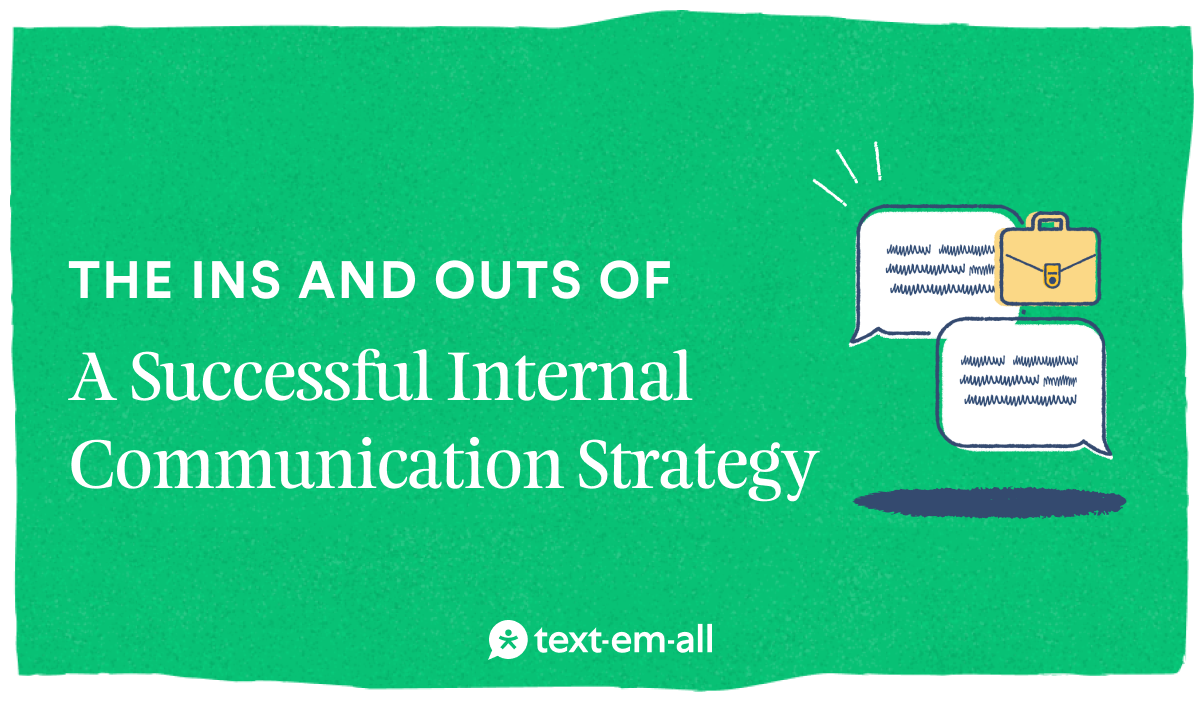
Effective communication is the backbone of any successful organization. It ensures that everyone is on the same page, working towards the same goals, and can lead to increased productivity, employee satisfaction, and overall success.
But when it comes to internal communication, it's not just about sending out emails or holding meetings. A well-crafted internal communication strategy is essential for fostering a positive and productive work environment. In this article, we'll dive into the ins and outs of a great internal communication strategy and provide tips for creating one for your organization.
Table of Contents
- What is an Internal Communication Strategy?
- Modern Internal Communication Strategies
- Elements of a Successful Internal Communication Plan
- Future-Proofing Your Communication Strategy
What is an Internal Communication Strategy?
An internal communication strategy is a comprehensive plan outlining how information is shared, received, and acted upon within an organization. It involves a set of processes, tools, and channels that facilitate effective communication among employees and various levels of management.
The Role of Internal Communications
Internal communications are pivotal in shaping employee engagement and overall organizational success. When employees are well-informed about company goals, values, and updates, they are more likely to align their efforts with the organization's mission and feel like they’re in the loop.
Since the employees are well informed, it gives them the freedom to do their jobs daily with clarity instead of confusion. This, in turn, positively impacts the company's bottom line because the employees can put their best foot forward.
The Impact of Internal Communications on Business Outcomes
Effective internal communication isn't just about convenience; it directly affects business outcomes and overall success. Clear and consistent internal communication can significantly improve productivity and employee morale, leading to higher retention rates and, ultimately, greater business success.
Effective internal communications directly contribute to increased productivity. According to Gallup, businesses with highly engaged teams, a result that is achievable through an internal communications strategy, experience a 20% increase in productivity. When employees receive clear and timely information, they can make informed decisions and execute tasks efficiently.
Additionally, a sense of belonging and connection fostered through internal communications reduces turnover rates, saving the organization time and resources. According to a recent survey, companies with strong internal communication practices are 50% more likely to report lower employee turnover rates.
Modern Internal Communication Strategies
In the digital age, traditional methods of internal communication are evolving to meet the demands of a dynamic workforce. Modern internal communication strategies leverage technology to enhance connectivity and accessibility.
Mass Text Messaging
In the past, texting was perceived as too informal for businesses to use in an internal communication strategy, however, mass text messaging has emerged as a powerful and popular tool. With so much email spam, it’s easy for emails to get lost in inboxes, making texting the preferred communication method. Here are some of the benefits of using mass texting for your internal communications:
Instant Reach and Immediacy
Mass text messaging offers unparalleled speed and reach, ensuring that critical information reaches employees promptly, regardless of their location or time zone.
Higher Open Rates and Engagement
With a staggering 98% open rate, text messages capture immediate attention and encourage active employee engagement, leading to higher responsiveness and participation.
Mobile-Centric Convenience
In today's mobile-centric world, mass text messaging aligns with employees' preferences and lifestyles, ensuring that important updates are delivered directly to their smartphones for easy access.
Personalization and Customization
Modern text messaging platforms allow organizations to personalize messages based on employee segments, which ensures that information is relevant and resonates with each recipient.
Real-Time Updates and Alerts
Mass text messaging is particularly effective for delivering urgent updates, alerts, and notifications in real time. It enables swift responses and actions from employees, especially during emergencies or time-sensitive situations.
Enhanced Employee Collaboration
Beyond one-way communication, text messaging facilitates quick exchanges and group communication, fostering collaboration and teamwork among employees regardless of their physical location.
Tracking Capabilities
Mass text messaging platforms often come equipped with features that enable organizations to track message delivery and engagement.
Measurable Impact on Employee Engagement
Implementing mass text messaging as part of an internal communication strategy yields measurable results, including increased employee engagement, improved responsiveness, and enhanced overall communication. Research shows that companies incorporating mass text messaging into their communication strategy experience an increase in employee responsiveness and engagement.
Automated Calling
Automated calling is another valuable addition to the modern internal communication toolkit. With the ability to deliver important messages or updates through automated voice calls, organizations can ensure that critical information is conveyed promptly.
Efficient Delivery of Important Messages
Automated calling systems enable organizations to deliver critical messages, updates, and announcements efficiently. This means that relevant stakeholders can receive important information almost instantaneously, ensuring everyone is informed and aligned without delays.
Immediate Response and Action
Phone calls often drive more urgency than emails or even text messages. By delivering messages via automated calls, organizations can prompt immediate responses or actions from employees, particularly in emergencies or when time-sensitive decisions need to be made.
In addition, using automated calls in conjunction with mass text messages can increase the likelihood that employees will hear or see your message and remember to take the desired action.
Accessibility for All Employees
Automated calling systems ensure that important information reaches all employees, including those who may not have access to smartphones or email. With automated calling, you can also reach your employees’ office phones, which can be more convenient since they’re already in the office.
Enhanced Reach and Reliability
Just like mass text messaging, automated calling helps you send your messages quickly and simultaneously, unlike traditional communication methods that rely on manual outreach. Since you can create contact groups, you minimize the risk of missing people in manual outreach.
Integration with Other Communication Channels
Automated calling systems can complement other communication channels, such as mass text messaging or email, providing organizations with a comprehensive and integrated approach to internal communications.
Targeted Messaging
Advanced automated calling systems allow organizations to target messages based on employee preferences or specific criteria, ensuring that information is relevant and tailored to individual needs.
Tracking and Reporting Capabilities
Automated calling systems often include features for tracking call delivery, response rates, and live answers vs. voicemails, providing valuable insights into the effectiveness of internal communication efforts and enabling organizations to make data-driven decisions.
Read Texting vs. Calling: Which Method Is More Effective?
Elements of a Successful Internal Communication Plan
A successful internal communication plan involves a strategic approach to ensure that messages are not only delivered, received, and understood. Here are key elements to consider:
.png?width=693&height=405&name=The%206%20Elements%20of%20Good%20Internal%20Communication%20(1).png)
1. Set Goals and Objectives
Define clear goals and objectives for your internal communication strategy. Whether it's improving employee engagement, reducing turnover, or enhancing collaboration, having specific targets will guide your communication efforts.
2. Understand Your Audience
Different employees have different communication preferences. Understanding your audience enables you to tailor your messages to resonate with diverse personalities and work styles.
3. Craft Clear Messages
Clarity is essential in internal communications. Craft messages that are concise, relevant, and easy to understand. Avoid jargon and ambiguity to ensure your messages are received as intended.
Read 6 Tips for Writing an Effective Text Message
4. Choose the Right Channels
While various communication channels are available, selecting the ones that resonate with your workforce is crucial. Texting and calling, in particular, offer immediacy and accessibility, making them effective channels for reaching employees in real-time.
5. Encourage Feedback
Communication is a two-way street. Encourage employees to provide feedback and actively listen to their concerns to foster a culture of openness and continuous improvement.
6. Evaluate and Adjust Your Strategy
Regularly assess the effectiveness of your internal communication strategy. Analyze metrics, gather feedback, and be willing to make adjustments to ensure ongoing improvement.
Future-Proof Your Communication Strategy
To ensure your internal communication strategy remains effective in the future, you must stay updated on new trends and technologies while aligning them with your organization's goals and values. Here are three ways you can future-proof your approach:
1. Stay Updated on Emerging Trends and Technologies
Adopt a Mindset of Continuous Learning: Encourage ongoing learning and development within your organization to keep up with industry trends and new technologies.
Conduct Industry Research: Invest in research to understand emerging trends and technologies that could impact internal communication.
Network: Build connections with industry experts and attend events to stay informed about the latest developments.
2. Embrace Innovations Aligned with Goals
Align with Broader Goals: Choose technologies and strategies that support your organization's objectives and values.
Test Pilot Programs: Test new ideas on a small scale before implementing them across the organization.
Be Agile: Be open to adapting and refining your strategies based on feedback and changing needs.
3. Evolve with the Workforce
Understand Employee Needs: Regularly gather feedback to understand how employees prefer to communicate and collaborate.
Support Flexible Work: Support flexible work arrangements by providing tools and resources for remote collaboration.
Consider Generational Communication Standards: Tailor communication strategies to meet the preferences of different age groups within your workforce.
By staying informed, adaptable, and responsive to your organization's and its employees' needs, you can ensure that your internal communication strategy remains effective and relevant in the future.
Implement a Sound Communication Strategy With Text-Em-All
A well-crafted internal communication strategy is essential for organizational success, but remember, communication isn't one-size-fits-all; understanding the audience and choosing the right channels is key.
Ready to elevate your internal communication strategy? Create your free Text-Em-All account today to explore the power of mass text messaging and automated calling.












